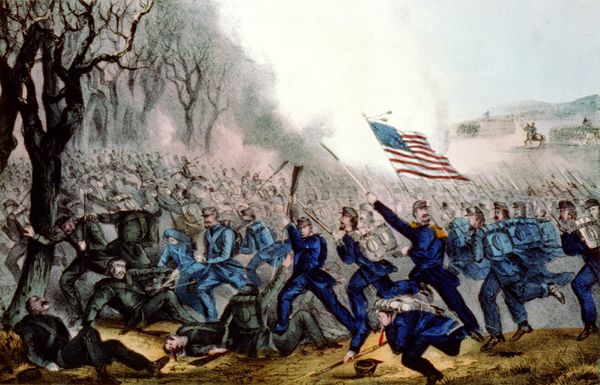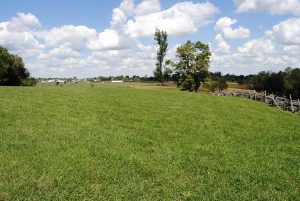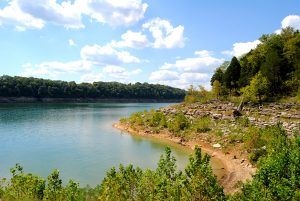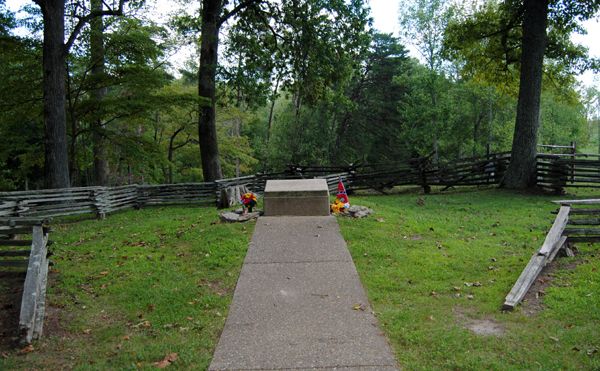The Battle of Mill Springs, also known as the Battle of Logan’s Cross-Roads and the Battle of Fishing Creek, occurred in Pulaski and Wayne Counties of south-central Kentucky on January 19, 1862. It was part of the Confederate Offensive in Eastern Kentucky.
In 1861, the critical border state of Kentucky declared neutrality in the fight to maintain the Union. However, its neutrality was first violated on September 3, 1861, when Confederate Brigadier General Gideon J. Pillow, acting on Major General Leonidas Polk’s orders, occupied Columbus. Two days later, Union General Ulysses S. Grant seized Paducah. Afterward, neither adversary respected the state’s proclaimed neutrality.
By early 1862, a single Confederate general, Albert Sidney Johnston, commanded all Arkansas forces to the Cumberland Gap. His forces were spread thinly over a broad defensive line. His left flank was General Polk in Columbus with 12,000 men. The center consisted of two forts under the command of Brigadier General Lloyd Tilghman, with 4,000 men.
Fort Henry and Fort Donelson were the sole positions to defend the important Tennessee and Cumberland Rivers. His right flank was in Kentucky, with Brigadier General Simon Bolivar Buckner’s 4,000 men in Bowling Green and about 4,000 in the Military District of East Tennessee under Major General George B. Crittenden, which was responsible for guarding the Cumberland Gap against Union intruders.
Just after midnight on January 19, 1862, Confederate troops at Beech Grove started a nine-mile slog towards a Union army camped at Logan’s Cross Roads. Rain, sleet, and fog filled the night, creating conditions so miserable that a Union soldier later noted:
“If we had known that the Confederates had turned out of their comfortable tents and dry blankets and were sloshing along in the mud, storm, and darkness for the next six weary hours, we could have much enjoyed contemplating their physical and spiritual condition. It was always some comfort to the soldier on a night such as this to think that his enemy over there was at least as cold and wretched as he himself was.”
The South had decided to attack the Union Army to protect the defensive line it had set up across southern Kentucky. Major General George B. Crittenden, who commanded the Confederate Army in this part of the country, had learned that Federal forces under Major General George Thomas were coming together at Logan’s Cross Roads. Crittenden and his commanders decided their best strategy was to strike now before additional Union troops arrived; if they waited, the Union would soon attack the South’s defenses near the community of Mill Springs. The Confederates desperately needed to hold their line because a loss would allow the North to gain control of the Cumberland Gap, the main route into southwest Virginia, and access the heart of Tennessee.
After six hours of marching in the dark, the Confederate troops encountered Federal pickets, and the Battle of Mill Springs began. For the next four hours, fighting ranged across hilly farmland that retained many patches of woods. Ravines cut across the battlefield, impeding the cavalry and artillery of both sides. This terrain was familiar to soldiers on each side, for both North and South included units made up of men from Kentucky.
At the start of the fighting, the Southern troops drove their opponents back. After about an hour, however, the battle began to stabilize. More Union forces arrived, and it became difficult to see as black powder in the rifles produced smoke mixed with the fog. The weather gradually affected the Confederates, who used old flint rifles that needed a spark to ignite their black powder, which lay exposed in an open pan. “The rain was descending in torrents, and our flintlock muskets were in bad condition; not one in three would fire,” wrote one Southern soldier. “We did the best we could with our old flintlocks. Mine went off once during the action, and although I wiped the ‘pan’ and primed a dozen times, it would do so no more.”
In this confusion, Brigadier General Felix K. Zollicoffer rode up to the 19th Tennessee Company, which held the Confederate center. He ordered them to cease fire, as he was convinced that they were shooting at other Southern units. The General then advanced toward the unit being fired on and began speaking with another officer, whom he also ordered to cease fire. Neither recognized the other’s face, and both men wore rubberized canvas raincoats, making it impossible to see a uniform. The other officer had turned away to follow his orders when one of Zollicoffer’s aides rode up and shouted for the General to get away – these were the enemy’s troops! Zollicoffer had been mistaken: the 19th Tennessee had been firing at the 4th Kentucky U.S., who still stood close enough to hear the warning. They opened fire, and Zollicoffer and his aide were killed instantly.
Even after Zollicoffer’s death, fighting continued for at least two more hours. The Confederates mounted one more significant attack, in which they advanced but could not break the Union lines. Then, the tide of the battle turned against the Confederates, particularly after the 9th Ohio made one of the first and most effective bayonet charges of the Civil War. They broke the Confederate left and caused the entire army to retreat in confusion. The Federal forces pursued, but rearguard action by some Southern units slowed the Union enough to allow the Confederates to reach their fortified camps, nine miles to the rear, as night fell.
During the night, as the Federals prepared to attack the camp at dawn, the beaten Confederates retreated hastily across the Cumberland River. When the Union army approached in the morning, they found their opponents were gone, having abandoned their artillery, wagons, horses, food, and most of their personal possessions. In a scene repeated frequently on both sides throughout the war, Union troops then plundered the enemy’s camp. “We have taken some of the nicest clothing I ever saw, broadcloth coats worth five to twenty dollars apiece. I got a satin vest worth five dollars, a shirt worth a dollar and a half, and a silver-handled stiletto, too,” wrote one soldier from Ohio to his father.
The defeat caused the Confederate defense line to collapse in eastern Kentucky, leaving the region under Federal control and eastern Tennessee open to invasion. The subsequent losses of Forts Henry and Donelson, both just over the border into Tennessee, forced all Confederate forces to retreat out of the state. Though the South would try to retake Kentucky later in 1862, this effort’s failure meant that the state remained firmly in control of the Union for the rest of the Civil War.
The estimated casualties of the battle were 232 Union and 439 Confederate. Of these, more than 200 were dead – 55 Federals and 148 Confederates. The Union dead lie in the National Cemetery next to the Mill Springs Battlefield Museum. The Confederate dead were buried in mass graves at the battlefield site. They are memorialized at the battlefield a few miles away.
The Mill Springs battlefield is in Pulaski County, near Nancy, Kentucky. The historic town of Mill Springs, named after the battle, is across Lake Cumberland. The Mill Springs Battlefield Association has protected portions of the battlefield by acquiring development rights to a largely rural landscape.
The battlefield covers about 105 acres and is considered a historic landmark. Several commemorative ceremonies are held annually at the battlefield, including candlelight tours, living history presentations, and occasional re-enactments.
While considered a small battle compared to many that followed in the Civil War, the Battle of Mill Springs was the second largest in Kentucky – only Perryville had higher casualties. It was also the first significant Union victory of the war, much celebrated in the popular press, but it was soon eclipsed by General Ulysses S. Grant’s victories at Forts Henry and Donelson.
The site of Zollicoffer’s death and a mass grave for Confederate troops may have been lost if not for the remembrances of 10-year-old Dorotha Burton in 1901. Growing up on a farm adjacent to the battlefield, Burton would decorate a nearby oak tree with a wreath of evergreens and a mass grave with wildflowers. That act inspired Confederate and Union Veterans and Zollicoffer’s daughters to erect a permanent remembrance in 1911.
More Information:
Mill Springs Battlefield Association
P.O. Box 282
9020 W. Hwy 80
Nancy, Kentucky 42544
606-636-4045
Compiled and edited by Kathy Alexander/Legends of America, updated March 2024.
Also See:





